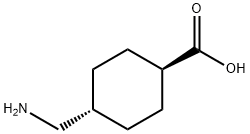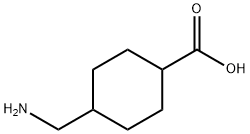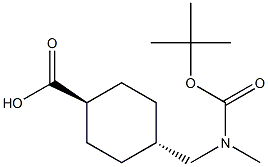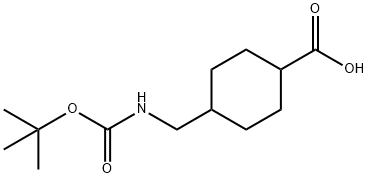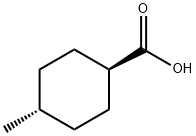trans-4-(Aminomethyl)cyclohexanecarboxylic acid , 98% , 1197-18-8
Synonym(s):
AMCA;AMCHA;HAKU;TAMCHA;Tranexamic acid
CAS NO.:1197-18-8
Empirical Formula: C8H15NO2
Molecular Weight: 157.21
MDL number: MFCD00001466
EINECS: 214-818-2
| Pack Size | Price | Stock | Quantity |
| 5G | RMB25.60 | In Stock |
|
| 10g | RMB48.80 | In Stock |
|
| 25G | RMB64.00 | In Stock |
|
| 50g | RMB127.20 | In Stock |
|
| 100G | RMB225.60 | In Stock |
|
| 250g | RMB543.20 | In Stock |
|
| 500G | RMB926.40 | In Stock |
|
| others | Enquire |
PRODUCT Properties
| Melting point: | >300 °C (lit.) |
| Boiling point: | 281.88°C (rough estimate) |
| Density | 1.0806 (rough estimate) |
| vapor pressure | 1.72hPa at 25℃ |
| refractive index | 1.4186 (estimate) |
| storage temp. | 2-8°C |
| solubility | Freely soluble in water and in glacial acetic acid, practically insoluble in acetone and in ethanol (96 per cent). |
| pka | pKa 4.3 (Uncertain);10.6 (Uncertain) |
| form | Crystalline Powder |
| color | White |
| Water Solubility | 1g/6ml |
| Merck | 14,9569 |
| BRN | 2207452 |
| Stability: | Hygroscopic |
| InChIKey | GYDJEQRTZSCIOI-LJGSYFOKSA-N |
| CAS DataBase Reference | 1197-18-8 |
Description and Uses
Tranexamic acid is a derivative of aminomethylbenzoic acid, and a kind of antifibrinolytic drugs to stop bleeding. The hemostasis mechanism of tranexamic acid is similar to aminocaproic acid and aminomethylbenzoic acid, but the effect is stronger. The strength is 7 to 10 times of aminocaproic acid, 2 times of aminomethylbenzoic acid, but toxicity is similar.
The chemical structure of tranexamic acid is similar to lysine, competitive inhibition of plasmin original in fibrin adsorption, to prevent their activation, protection fiber protein not to degrade by plasmin and dissolve, eventually achieve hemostasis. Applicable in the treatment of acute or chronic, localized or systemic primary fiber fibrinolytic hyperthyroidism caused by bleeding, such as obstetric hemorrhage, renal hemorrhage, hemorrhage of hypertrophy of the prostate, hemophilia, pulmonary tuberculosis hemoptysis, stomach bleeding, after operation of liver, lung, spleen and other viscera hemorrhage; also can be used in surgery when abnormal bleeding etc..
Clinical tranexamic acid has effect significantly to insect bites disease, dermatitis and eczema, simple purpura, chronic urticaria, artificial sex urticaria, toxic eruption and eruption. And also has a certain effect on erythroderma, scleroderma, systemic lupus erythematosus (SLE), Erythema multiforme, shingles and alopecia areata. Treatment of hereditary angioedema effect is also good. In the treatment of Chloasma, general medicine is effective about 3 weeks, markedly effective 5 weeks, a course of 60 days. Given orally in doses of 0.25 ~ 0.5 g, a day 3 ~ 4 times. A few patients can nausea, fatigue, pruritus, abdominal discomfort, and diarrhea side effects after withdrawal symptoms disappear.
Fibrinolysis, the cleavage of fibrin by plasmin, is a normal step in the dissolution of fibrin clots after wound repair. Tranexamic acid is an inhibitor of fibrinolysis that blocks the interaction of plasmin with fibrin (IC50 = 3.1 μM). It is a lysine mimetic that binds the lysine binding site in plasmin. Antifibrinolytic agents have value when fibrinolytic activity is abnormally high or when coagulation is impaired.
Safety
| Symbol(GHS) |  GHS07 |
| Signal word | Warning |
| Hazard statements | H315-H319-H335 |
| Precautionary statements | P261-P264-P271-P280-P302+P352-P305+P351+P338 |
| Hazard Codes | Xi |
| Risk Statements | 36/37/38 |
| Safety Statements | 26-36-37/39 |
| WGK Germany | 2 |
| RTECS | GU8400000 |
| HazardClass | IRRITANT |
| HS Code | 29224999 |
| Toxicity | LD50 in mice, rats (mg/kg): 1500, 1200 i.v. (Melander) |

